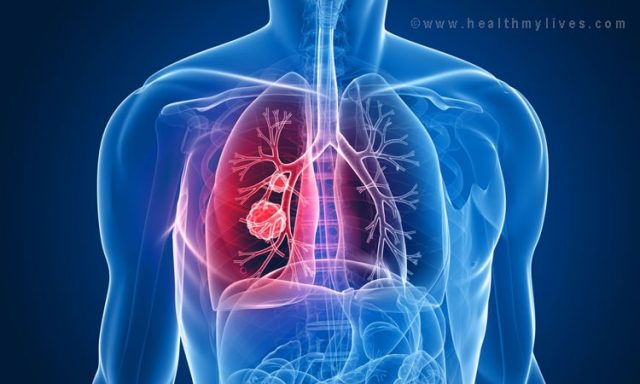This post was most recently updated on July 25th, 2023
Overview
It is estimated that each year in the USA, more than 609,640 people die from cancer, and an additional 1,735,350 new cases are recorded.
Let’s help to reduce this number by learning about common cancers in women because there are so many cancers we can control if detected early.
Consult with leading oncologists to find out the most common cancers in women and how to prevent these dangerous diseases.
List of common cancers in women
Here is the list of common cancer which can be seen in most of the women:
1. Colorectal cancer

Colorectal cancer is the 3rd most common cancer in the world, with about 1.4 million new cases each year.
Colorectal cancer is caused by cancer cells that affect the colon or rectum.
The disease begins with the growth of a concentrated group of cells in a structure called a polyp on the wall of the colon or rectum.
Therefore, the detection and removal of polyps play a significant role in preventing colorectal cancer.
Symptoms of colorectal cancer
People with colorectal cancer will often have symptoms:
- Swollen stomach.
- Bloody bowel movements.
- Nausea or vomiting.
- Bleeding in the anus.
- Weakness, fatigue.
- Diarrhea or constipation.
- Unexpected weight loss.
- Frequent belching, abdominal pain.
- Abdominal bloating.
Ways to prevent colorectal cancer
Routine colorectal cancer screening is an effective way to prevent rectal cancer.
Rectoscopy is the most effective screening method, starting at the age of 45 and having regular screening every ten years.
When performing a colonoscopy, your doctor will insert a very thin and flexible tube into the rectum and observe any abnormal structures if there are any in them.
The colonoscopy not only helps doctors to detect rectal cancer but also allows the detection of rectal polyps and their removal promptly before they progress and cause cancer.
Other screening options include stool tests and blood tests.
Your doctor may perform blood tests to look for cancer signs or perform a stool DNA test using a method called Cologuard to detect genetic changes that can lead to cancer.
However, these methods can lead to false positives and still require colonoscopy to give an accurate diagnosis.
2. Thyroid cancer

Thyroid cancer occurs when there is an abnormal growth of thyroid cells.
The thyroid gland, located in the neck, is responsible for creating hormones that control metabolism.
Cells in the thyroid gland are called follicular and paracellular cells.
Symptoms of thyroid cancer
- Usually, the onset of thyroid cancer will have no signs and symptoms. If so, the first sign appears a thyroid tumor.
- When cancer develops, the disease usually spreads to nearby organs and causes hoarseness, difficulty swallowing, swollen lymph glands, and neck pain.
Ways to prevent thyroid cancer
If the doctor detects a small nodule, the patient should follow a doctor’s prescription for advance control instead of performing surgery.
If surgery is still needed in the end, cutting off half of the thyroid gland instead of removing the entire thyroid may be a good option.
In doing so, the patient does not have to use the thyroid hormone instead.
If your doctor recommends removing the entire thyroid gland even if you only have a nodule less than 1 cm in size, you should consult with other experts.
Thyroid surgery has specific risks, such as possible damage to the vocal cords, and you will need to use thyroid hormone replacement after surgery until the end of life.
3. Endometrial cancer

Endometrial cancer is a type of cancer that occurs in the uterus, that is, the pear-shaped hollow part of the pelvis in women in the fetus.
Endometrial cancer affects women primarily after perimenopause, with an average age of 60 onsets. At present, there is no effective screening for early detection of the disease.
Symptoms of endometrial cancer
- Abnormal vaginal discharge.
- Paining in the pelvic region.
- Vaginal irregular bleeding after menopause.
- Urination more often.
- Urine may leak during arterial movement or cause pain when urinating.
Ways to prevent endometrial cancer
Some ways to prevent this disease are to control weight properly.
According to the American Cancer Society, the risk of endometrial cancer doubles in overweight women and triples in obese women.
Fat cells secrete estrogen, a hormone that can make changes that can lead to cancer.
If women in the postmenopausal period use oral contraceptives, consider taking the pill for a few years.
According to a study published in the prestigious medical journal Lancet Oncology, using drugs for five years can reduce the risk of endometrial cancer by 25%.
4. Lung cancer

Lung cancer occurs when lung cells grow at an abnormally fast speed, causing a tumor to form.
The lungs help you to breathe and provide oxygen to the rest of the body.
According to WHO, lung cancer is the most common cause of cancer deaths.
Lung cancer can cause disability and affect your daily life.
According to the American Lung Association, the number of lung cancer cases in women has increased by 98% in the past four decades, and more than half of women with lung cancer have never smoked.
Some hypotheses are that women’s lungs are more sensitive to secondhand smoke, and estrogen may have been fuel for cancer cells.
Symptoms of lung cancer
- Shortness of breath.
- Difficulty swallowing.
- Hoarseness.
- Wheezing.
- Blood in the sputum.
- Feeling tired.
- Unexplained and unexpected weight loss.
- Discomfort or pain in the chest.
- Inflammation or blockage in the lungs.
- The cough does not get better or gets worse over time.
- Swollen or enlarged lymph nodes in the chest or area between the lungs.
Ways to prevent lung cancer
Do not smoke and stay away from secondhand smoke.
Tobacco smoke increases the risk of lung cancer by 30%.
If you’ve ever smoked before or repeatedly lived in a passive smoke environment, you should talk to your doctor about having a pulmonary function test.
Depending on your current condition, your doctor may prescribe a daily dose of 325 mg aspirin.
Research shows that this dose of aspirin helps prevent lung cancer effectively.
5. Breast cancer

Breast cancer is a malignant tumor that develops in breast cells.
Melanoma is a collection of cancer cells that can reproduce very quickly in surrounding tissues, or can spread to other parts of the body.
Breast cancer mostly occurs in women. However, in rare cases, men can also get this disease.
In the US, according to statistics, in 2010, our country had 206,966 cases of breast cancer, and by 2020, this number is estimated to account for 41,760.
Symptoms of breast cancer
Early breast cancer is usually painless and may be asymptomatic.
About 10% of patients have no pain, no tumor, or any sign of the disease.
However, if the breast tumor develops, the disease may cause the following symptoms:
- A hard lump in the breast
- The breast is changed in size or shape
- Breast discharge, indentation, or pain.
- Breasts that are swollen, deformed or irritated in the breast area or under the arms
- An areola or nipple changes in color or other changes, such as wrinkles or crusts.
Ways to prevent breast cancer
Routine mammograms are essential for breast cancer screening.
You should ask your doctor when you should begin conducting the screening. The American Cancer Society recommends this screening every year since age 45.
Along with screening is to adjust your habits and lifestyle to avoid being sedentary, being overweight, and consuming too much fat.
You should not drink alcohol because alcohol increases the risk of breast cancer.
A healthy diet and lifestyle can help prevent common cancers in women. So please adjust now and checkup every six months to ensure your health!


